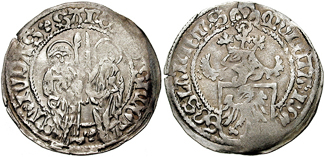
The Bauerngroschen, also Burgroschen (Low German: Buur, "farmer"), was a groschen minted in the Free Imperial City of Goslar from 1477 until at least 1490 and continued to circulate until the 16th century.[1] On the obverse it depicts a coat of arms with an imperial eagle beneath a helmet with a crown and on the reverse Saints, Simon and Jude. The two apostles were thought by the people to be farmers due to the poor quality stamping of the coins, hence the name, Bauerngroschen ("farmer's groschen").[2][3]
- ^ Bayerisches Münzkontor: mindestens bis 1490 geprägt, bis ins 16. Jahrhundert im Umlauf.
- ^ Friedrich von Schrötter …: Wörterbuch der Münzkunde …, p. 64.
- ^ Heinz Fengler, …: transpress Lexikon Numismatik …, p. 35.
© MMXXIII Rich X Search. We shall prevail. All rights reserved. Rich X Search
